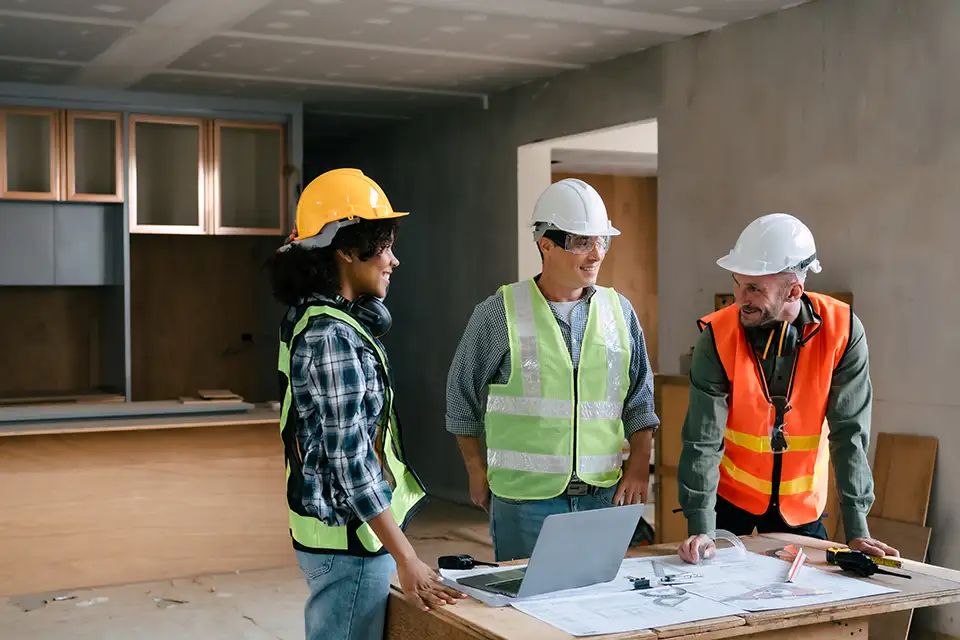On a bustling construction site, where machinery and manpower shape the future skyline, it’s worth pausing to consider what really holds everything together. Beyond the steel, concrete, and blueprints, there’s an essential network that’s just as vital as the physical foundation.
How often do we think about the role of advanced connectivity in our projects? Imagine a scenario where every decision and design is enhanced by the speed and precision of the latest digital technology.
What if the real key to the future of construction isn’t just in the materials we use but in the internet connectivity we integrate? As we push the boundaries of innovation, it’s time to see high-speed, reliable internet as the new backbone of the construction industry.
What you will learn from this blog:
- Introduction
- Briefly introduce the concept of digital transformation in the construction industry.
- Highlight the importance of connectivity in leveraging technological innovations.
- The Rise of Smart Construction Sites
- Discuss IoT devices’ role in enhancing safety and operational efficiency.
- Example of wearables for monitoring health and environmental conditions.
- The necessity of reliable connectivity for real-time data exchange.
- Building Information Modeling (BIM): Collaboration in the Cloud
- Explain BIM and its benefits for project planning and collaboration.
- Impact of high-speed internet on accessing BIM software and cloud storage.
- 3D Printing and Modular Construction: The Need for Speed
- Overview of 3D printing and modular construction as game-changers.
- The role of connectivity in enabling these technologies in remote fabrication sites.
- AI and Machine Learning: Predictive Analytics and Beyond
- The application of AI and machine learning for project management and design.
- Importance of internet speed and bandwidth for processing large datasets.
- Virtual and Augmented Reality (VR/AR): Immersive Planning and Training
- Benefits of VR/AR in training and project visualization.
- Connectivity requirements for immersive, lag-free experiences.
- Digital Twins: The Blueprint of Tomorrow
- Introduction to digital twins and their significance in construction.
- How continuous data exchange requires stable and fast internet connections.
- The Challenge of Connectivity in Remote Construction Sites
- Connectivity Challenges: Innovating beyond limitations in remote construction sites.
Universal Technology Access: Bridging gaps with portable and satellite connectivities.
- Connectivity Challenges: Innovating beyond limitations in remote construction sites.
- Conclusion
- Summarise the transformative potential of connectivity and technology in construction.
- Call to action for industry leaders to invest in connectivity infrastructure.

Introduction
The construction industry is becoming increasingly dynamic, the digital revolution is laying down new pathways to efficiency, safety, and sustainability. As we witness the integration of groundbreaking technologies, from the Internet of Things (IoT) to Artificial Intelligence (AI) and beyond, one foundational element emerges as crucial: fast, reliable connectivity.
High-speed, reliable internet is no longer just an operational tool; it’s the lifeline of modern construction sites striving to innovate and create competitive advantage. It enables real-time collaboration, data analysis, and the deployment of advanced technological solutions. This article delves into the core innovations transforming the construction sector and underscores the indispensable role of connectivity in realizing their full potential.
The Rise of Smart Construction Sites
The concept of smart construction sites represents a paradigm shift in how projects are managed and executed. At the forefront of this transformation are IoT devices, capable of monitoring environmental conditions, tracking equipment, and ensuring worker safety through wearable technology. For instance, sensors embedded in construction helmets can monitor vital signs and environmental factors, alerting managers to potential health risks or hazardous conditions in real-time.
However, the efficacy of these devices hinges on their ability to transmit data instantaneously, necessitating a robust connectivity framework. Without a robust internet connection, the promise of IoT to enhance operational efficiency and safety remains unfulfilled. Thus, the evolution of construction sites into interconnected, intelligent ecosystems is fundamentally linked to the availability and reliability of internet connectivity.
Building Information Modeling (BIM): Collaboration in the Cloud
Building Information Modeling (BIM) has transfigured project planning and execution, offering a 3D visual and data-rich platform for architects, engineers, and contractors. BIM facilitates unparalleled collaboration, allowing all stakeholders to access, update, and share project information in real-time. The cloud-based nature of BIM software exemplifies the critical need for high-speed internet connectivity, enabling seamless access and collaboration regardless of geographical location.
Moreover, the integration of BIM with cloud storage solutions amplifies its effectiveness, allowing for the centralization of vast datasets and models. This synergy between BIM and cloud services not only optimizes project management and design but also enhances the decision-making process, ensuring that all stakeholders are informed and aligned. Yet, the cornerstone of this integration—reliable, high-speed internet—cannot be overlooked, as it enables the real-time data exchange essential for BIM’s success.
3D Printing and Modular Construction: The Need for Speed
The adoption of 3D printing and modular construction techniques marks a significant evolution in building practices, offering a path to increased efficiency, reduced waste, and enhanced customization. 3D printing in construction, particularly for off-site fabrication of building components, relies heavily on the transmission of large design files and continuous monitoring of the printing process. Similarly, modular construction benefits from connectivity through the streamlined coordination of fabrication processes and on-site assembly schedules.
The role of connectivity in these scenarios extends beyond data transmission; it facilitates the rapid sharing of design updates, real-time monitoring of production quality, and efficient logistics planning. High-speed internet becomes a critical asset, ensuring that off-site fabrication units and construction sites remain in sync, bridging the physical distance with digital connectivity.
AI and Machine Learning: Predictive Analytics and Beyond
Artificial Intelligence (AI) and Machine Learning (ML) are here and will affect every industry, driving unprecedented efficiencies and delivering unprecedented insights for the construction industry. AI applications range from predictive analytics, which forecasts project risks and material needs, to machine learning algorithms that optimize scheduling and resource allocation. For instance, AI can predict potential delays caused by weather, supply chain disruptions, or labor shortages, allowing project managers to proactively adjust their plans.
The crux of leveraging AI and ML lies in their need for vast amounts of data, which must be collected, processed, and analyzed in real-time. This is where connectivity steps in as a backbone, enabling the seamless flow of data from site sensors, equipment, and systems to AI algorithms. High-speed, reliable internet ensures that AI tools can provide timely, actionable insights, making connectivity not just a facilitator but a catalyst for AI-driven innovation in construction.

Virtual and Augmented Reality (VR/AR): Immersive Planning and Training
Virtual Reality (VR) and Augmented Reality (AR) are redefining the planning, training, and presentation phases of construction projects. VR allows stakeholders to immerse themselves in fully navigable 3D models of proposed structures, offering a detailed pre construction visualization. AR, on the other hand, overlays digital information onto the physical job site, aiding in accurate, real-time comparisons between plans and the built environment.
Both VR and AR demand high bandwidth and low latency to deliver smooth, immersive experiences without delays or disruptions. As these technologies become integral to the construction process, the need for fast connectivity becomes even more pronounced. Whether it’s for client presentations, design validation, or worker training, VR and AR’s effectiveness is directly tied to the quality of the internet connection, making it an essential consideration for construction firms integrating these technologies.
Digital Twins: The Blueprint of Tomorrow
Digital twins are virtual replicas of physical assets, processes, or systems, offering a dynamic, real-time reflection of their real-world counterparts. In construction, digital twins serve multiple purposes, from simulating building performance under various conditions to monitoring ongoing projects for deviations from plans. They enable a continuous feedback loop between the digital and physical realms, facilitating adjustments and optimizations before, during, and after construction.
Creating and maintaining digital twins requires the constant collection and analysis of data from numerous sources, including IoT devices, BIM models, and operational systems. This extensive data exchange underlines the importance of dependable, high-speed connectivity. Without it, the potential of digital twins to improve project outcomes, enhance efficiency, and reduce costs cannot be fully realized. Connectivity not only supports the operational demands of digital twins but also empowers stakeholders to make informed decisions based on comprehensive, up-to-date information.
The Challenge of Connectivity in Remote Construction Sites
One of the constant challenges in construction is securing reliable, high-quality internet access at every job site, particularly in remote or developing areas. Fiber is often not available in these areas and the speed and reliability offered by other terrestrial solutions is not on par with the requirements of a modern business. To overcome this, the industry is turning to innovative solutions like fixed wireless internet access through dedicated solutions or via portable cellular routers and satellite internet. These technologies ensure that advanced tools can be used everywhere, highlighting the industry’s dedication to innovation and the crucial role of connectivity in driving technological progress, no matter the location.
Conclusion
The construction industry’s future is undeniably digital, marked by the adoption of technologies that promise to revolutionize how projects are planned, executed, and managed. At the heart of this transformation is the need for reliable, high-speed internet connections, enabling the seamless flow of data essential for these technologies to realize their full value.
As construction firms navigate this digital landscape, prioritizing and investing in robust internet infrastructure will be key to unlocking the potential of innovations designed to enhance efficiency, safety, and sustainability. The connectivity imperative, therefore, stands as both a challenge and an opportunity for the construction industry to build smarter, faster, and more resiliently in an ever-evolving world.

